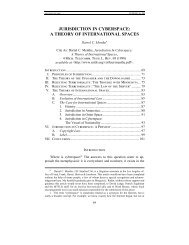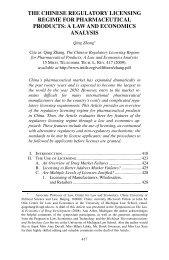Fracking Patents - Michigan Telecommunications and Technology ...
Fracking Patents - Michigan Telecommunications and Technology ...
Fracking Patents - Michigan Telecommunications and Technology ...
- No tags were found...
You also want an ePaper? Increase the reach of your titles
YUMPU automatically turns print PDFs into web optimized ePapers that Google loves.
Spring 2013] <strong>Fracking</strong> <strong>Patents</strong> 285job in history,” consisting of 250,000 gallons of fresh water, 200,000 poundsof s<strong>and</strong> <strong>and</strong> 4,500 hydraulic horsepower of pumping. 21 The following year a500,000 gallon waterfrac was completed, with expectations that “the firstmillion-gallon treatment may soon be performed.” 22Over the second half of the twentieth century, hydraulic fracturing technologiescontinued to evolve. By 1997, Mitchell Energy had been “experimenting”in the Barnett Shale for some 16 years, but had yet to figure outhow to economically recover gas there. 23 It was at this point that MitchellEnergy tried so-called slickwater hydraulic fracturing treatments. 24 Theyfound that well performance was somewhat better than the crosslinked jobs,but stimulation costs were reduced by approximately 65%. 25 By the end of1998, it seemed the company had finally achieved its breakthrough. 26 In particular,waterfracs were significantly cheaper than massive hydraulic fracture(“MHF”) treatments with no loss of performance. 27 The stimulation cost reductionsallowed Mitchell to complete fracturing in the Upper Barnett Shalein Denton <strong>and</strong> Wise Counties as well as the Lower Barnett Shale, increasingexpected ultimate recoveries (“EURs”) by roughly 20% to 25%. 28In 2001, Devon Energy CEO Larry Nichols noticed a sudden surge ingas supply from the Barnett Shale area. “If fracking was not working, whywas Mitchell’s output going up?” 29 Suspecting that Mitchell Energy had finallycracked the code to the Barnett Shale, in August 2001 Devon reachedagreement on a $3.5 billion acquisition of Mitchell. 30 According to Nichols,“At that time, absolutely no one believed that shale drilling worked, otherthan Mitchell <strong>and</strong> us.” 31At the time of its acquisition, Mitchell Energy had drilled about 400wells in the Barnett, <strong>and</strong> executives had publicly announced the potential for(1956). In 1960, Dow Chemical <strong>and</strong> Schlumberger established Dowell Schlumberger, a 50/50joint venture offering well completion services outside the United States <strong>and</strong> Canada. In 1984,Schlumberger paid $440 million to acquire a half interest in the Dowell Division, which wasthen integrated into Dowell Schlumberger. In 1993, Schlumberger acquired Dow’s remaining50% interest in the company. See PAUL OREFFICE, ONLY IN AMERICA 225–27 (2006).21. Biggest Fracture Job, 3 PETROLEUM WK. 17 (1956).22. Anthony Gibbon, Fresh Water Is Becoming Favorite Fracturing Fluid, WORLD OIL76, 77 (1957).23. George Waters et al., Use of Horizontal Well Image Tools to Optimize Barnett ShaleReservoir Exploitation 1 (Soc’y of Petroleum Eng’rs, SPE 103202, 2006), available at http://www.onepetro.org/mslib/servlet/onepetropreview?id=SPE-103202-MS; see also DANIEL YER-GIN, THE QUEST: ENERGY, SECURITY, AND THE REMAKING OF THE MODERN WORLD ch. 16(2011).24. Waters et al., supra note 23.25. Id.26. YERGIN, supra note 23.27. Waters et al., supra note 23.28. Id.29. YERGIN, supra note 23.30. Id.31. Id.






